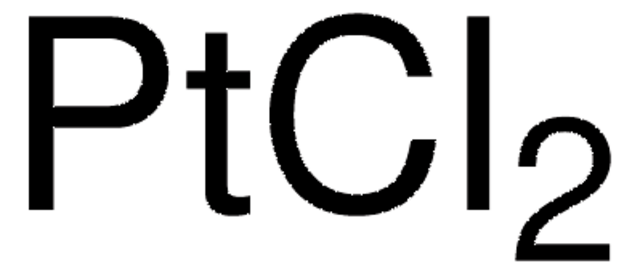Kluczowe dokumenty
206105
Ammonium tetrachloroplatinate(II)
99%
Synonim(y):
Platinum(II)-ammonium chloride
About This Item
Polecane produkty
Poziom jakości
Próba
99%
Formularz
solid
mp
140 °C (dec.) (lit.)
gęstość
2.936 g/mL at 25 °C (lit.)
ciąg SMILES
[H][N+]([H])([H])[H].[H][N+]([H])([H])[H].Cl[Pt--](Cl)(Cl)Cl
InChI
1S/4ClH.2H3N.Pt/h4*1H;2*1H3;/q;;;;;;+2/p-2
Klucz InChI
QJIMNDWDOXTTBR-UHFFFAOYSA-L
Szukasz podobnych produktów? Odwiedź Przewodnik dotyczący porównywania produktów
Zastosowanie
- Deactivation study of the hydrodeoxygenation of p-methylguaiacol: Studies catalysts prepared using ammonium tetrachloroplatinate(II), focusing on sustainable chemical processes relevant across academic research (Bouxin et al., 2017).
Cechy i korzyści
Hasło ostrzegawcze
Danger
Zwroty wskazujące rodzaj zagrożenia
Zwroty wskazujące środki ostrożności
Klasyfikacja zagrożeń
Acute Tox. 3 Oral - Eye Dam. 1 - Resp. Sens. 1 - Skin Irrit. 2 - Skin Sens. 1
Kod klasy składowania
6.1C - Combustible acute toxic Cat.3 / toxic compounds or compounds which causing chronic effects
Klasa zagrożenia wodnego (WGK)
WGK 1
Temperatura zapłonu (°F)
Not applicable
Temperatura zapłonu (°C)
Not applicable
Środki ochrony indywidualnej
Eyeshields, Faceshields, Gloves, type P2 (EN 143) respirator cartridges
Wybierz jedną z najnowszych wersji:
Masz już ten produkt?
Dokumenty związane z niedawno zakupionymi produktami zostały zamieszczone w Bibliotece dokumentów.
Klienci oglądali również te produkty
Nasz zespół naukowców ma doświadczenie we wszystkich obszarach badań, w tym w naukach przyrodniczych, materiałoznawstwie, syntezie chemicznej, chromatografii, analityce i wielu innych dziedzinach.
Skontaktuj się z zespołem ds. pomocy technicznej












